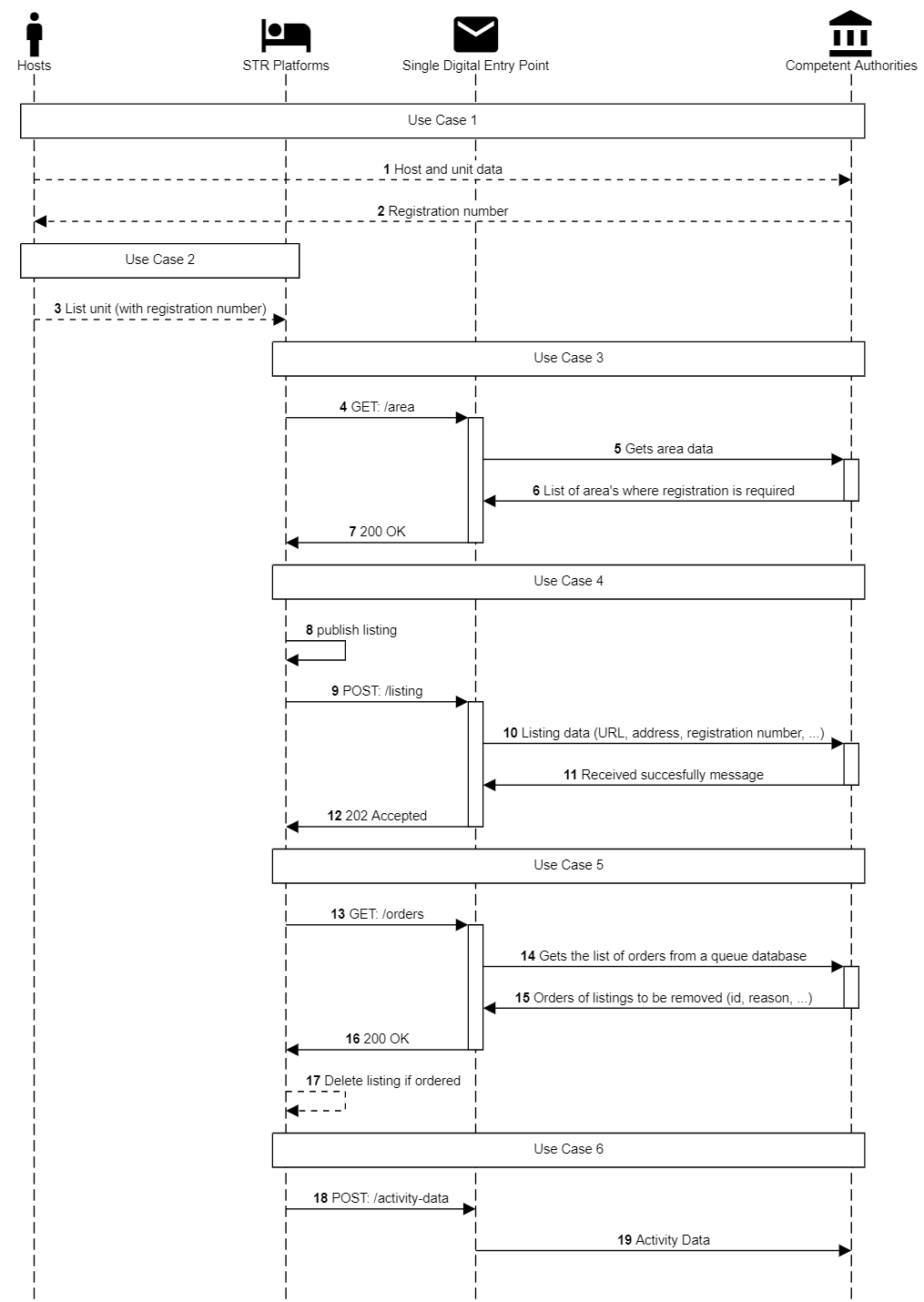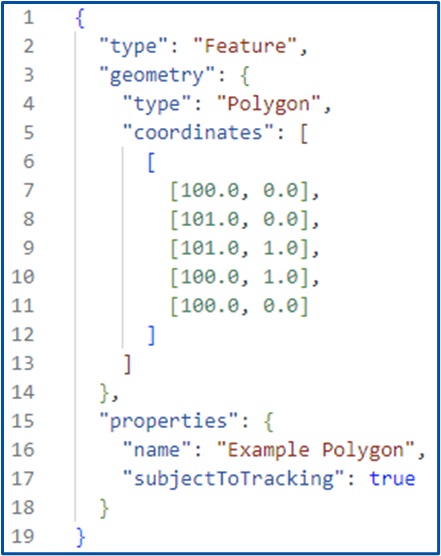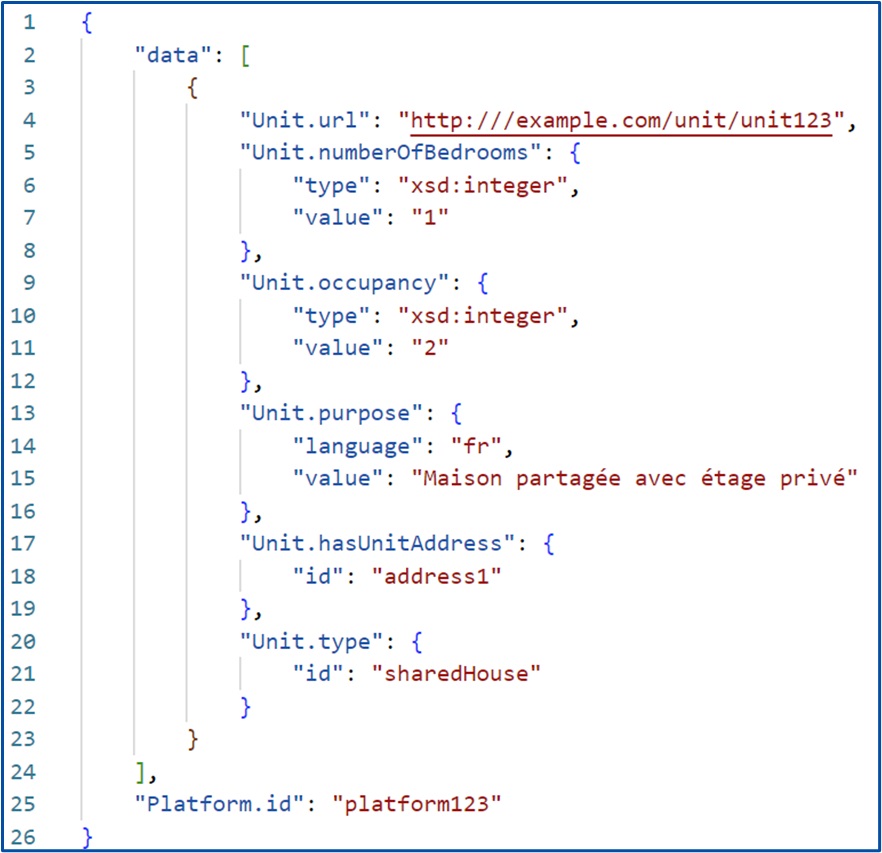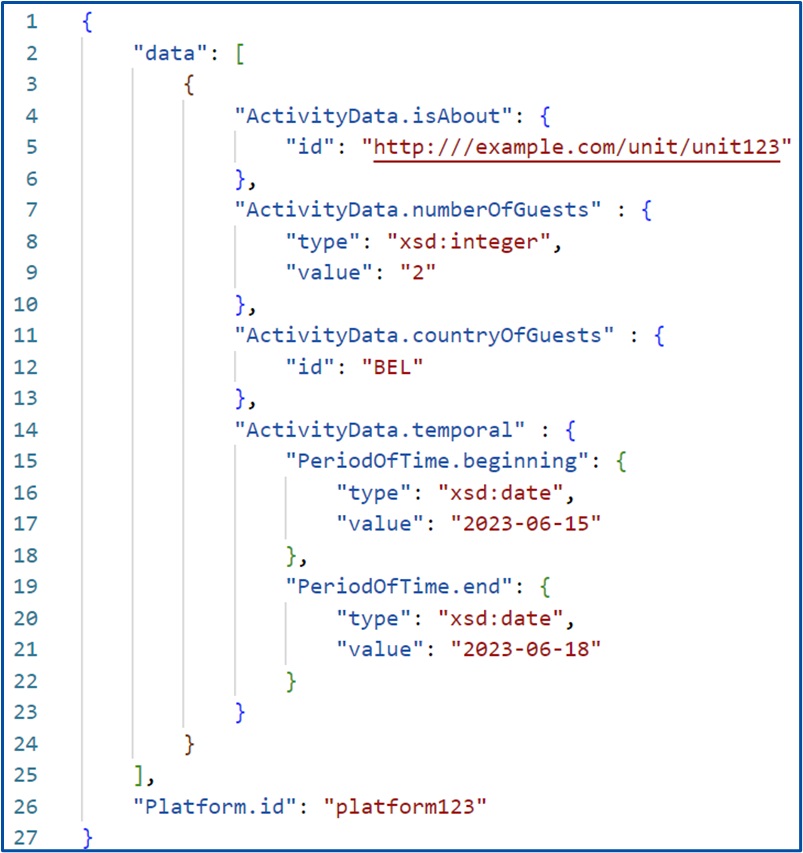| Activity Data |
https://w3id.org/str/ActivityData |
|
country of the guests |
https://w3id.org/str/countryOfGuests |
| Activity Data |
https://w3id.org/str/ActivityData |
|
is about |
https://w3id.org/str/isAbout |
| Activity Data |
https://w3id.org/str/ActivityData |
|
number of guests |
https://w3id.org/str/numberOfGuests |
| Activity Data |
https://w3id.org/str/ActivityData |
|
temporal |
http://purl.org/dc/terms/temporal |
| Address |
http://www.w3.org/ns/locn#Address |
|
address area |
http://www.w3.org/ns/locn#addressArea |
| Address |
http://www.w3.org/ns/locn#Address |
|
address ID |
http://www.w3.org/ns/locn#addressId |
| Address |
http://www.w3.org/ns/locn#Address |
|
administrative unit level 1 |
http://www.w3.org/ns/locn#adminUnitL1 |
| Address |
http://www.w3.org/ns/locn#Address |
|
administrative unit level 2 |
http://www.w3.org/ns/locn#adminUnitL2 |
| Address |
http://www.w3.org/ns/locn#Address |
|
full address |
http://www.w3.org/ns/locn#fullAddress |
| Address |
http://www.w3.org/ns/locn#Address |
|
land register |
https://w3id.org/str/landRegister |
| Address |
http://www.w3.org/ns/locn#Address |
|
locator designator |
http://www.w3.org/ns/locn#locatorDesignator |
| Address |
http://www.w3.org/ns/locn#Address |
|
locator name |
http://www.w3.org/ns/locn#locatorName |
| Address |
http://www.w3.org/ns/locn#Address |
|
post code |
http://www.w3.org/ns/locn#postCode |
| Address |
http://www.w3.org/ns/locn#Address |
|
post name |
http://www.w3.org/ns/locn#postName |
| Address |
http://www.w3.org/ns/locn#Address |
|
post office box |
http://www.w3.org/ns/locn#poBox |
| Address |
http://www.w3.org/ns/locn#Address |
|
thoroughfare |
http://www.w3.org/ns/locn#thoroughfare |
| Catalogue |
http://www.w3.org/ns/dcat#Catalog |
Recommended |
dataset |
http://www.w3.org/ns/dcat#dataset |
| Catalogue |
http://www.w3.org/ns/dcat#Catalog |
Recommended |
service |
http://www.w3.org/ns/dcat#service |
| Catalogue |
http://www.w3.org/ns/dcat#Catalog |
Optional |
record |
http://www.w3.org/ns/dcat#record |
| Catalogue Record |
http://www.w3.org/ns/dcat#CatalogRecord |
Mandatory |
primary topic |
http://xmlns.com/foaf/0.1/primaryTopic |
| Catalogued Resource |
http://www.w3.org/ns/dcat#Resource |
|
|
|
| Concept |
http://www.w3.org/2004/02/skos/core#Concept |
|
|
|
| Contact Point |
http://data.europa.eu/m8g/ContactPoint |
|
has email |
http://data.europa.eu/m8g/email |
| Contact Point |
http://data.europa.eu/m8g/ContactPoint |
|
has telephone |
http://data.europa.eu/m8g/telephone |
| Coordination Group |
https://w3id.org/str/CoordinationGroup |
|
member |
http://xmlns.com/foaf/0.1/member |
| Cost |
http://data.europa.eu/m8g/Cost |
|
currency |
http://data.europa.eu/m8g/currency |
| Cost |
http://data.europa.eu/m8g/Cost |
|
has value |
http://data.europa.eu/m8g/hasValue |
| Cost |
http://data.europa.eu/m8g/Cost |
|
identifier |
http://purl.org/dc/terms/identifier |
| Data Service |
http://www.w3.org/ns/dcat#DataService |
Recommended |
serves dataset |
http://www.w3.org/ns/dcat#servesDataset |
| Dataset |
http://www.w3.org/ns/dcat#Dataset |
Recommended |
dataset distribution |
http://www.w3.org/ns/dcat#distribution |
| Distribution |
http://www.w3.org/ns/dcat#Distribution |
Optional |
access service |
http://www.w3.org/ns/dcat#accessService |
| Distribution |
http://www.w3.org/ns/dcat#Distribution |
|
has listing |
https://w3id.org/str/hasListing |
| Document |
http://xmlns.com/foaf/0.1/Document |
|
|
|
| Evidence |
http://data.europa.eu/m8g/Evidence |
|
describes |
https://w3id.org/str/describes |
| Evidence |
http://data.europa.eu/m8g/Evidence |
|
identifier |
http://purl.org/dc/terms/identifier |
| Evidence |
http://data.europa.eu/m8g/Evidence |
|
name |
http://purl.org/dc/terms/title |
| Evidence |
http://data.europa.eu/m8g/Evidence |
|
related documentation |
http://xmlns.com/foaf/0.1/page |
| Evidence |
http://data.europa.eu/m8g/Evidence |
|
submission date |
https://w3id.org/str/submissionDate |
| Evidence |
http://data.europa.eu/m8g/Evidence |
|
update date |
https://w3id.org/str/updateDate |
| Evidence |
http://data.europa.eu/m8g/Evidence |
|
validity period |
http://data.europa.eu/m8g/validityPeriod |
| Geometry |
http://www.w3.org/ns/locn#Geometry |
|
coordinates |
http://data.europa.eu/m8g/coordinates |
| Geometry |
http://www.w3.org/ns/locn#Geometry |
|
geometry type |
http://data.europa.eu/m8g/geometryType |
| Geometry |
http://www.w3.org/ns/locn#Geometry |
|
latitude |
http://data.europa.eu/m8g/latitude |
| Geometry |
http://www.w3.org/ns/locn#Geometry |
|
longitude |
http://data.europa.eu/m8g/longitude |
| Group |
http://xmlns.com/foaf/0.1/Group |
|
|
|
| Identifier |
http://www.w3.org/ns/adms#identifier |
Mandatory |
notation |
http://www.w3.org/2004/02/skos/core#notation |
| Legal Entity |
http://www.w3.org/ns/legal#LegalEntity |
|
has legal representative |
https://w3id.org/str/hasLegalRepresentative |
| Legal Entity |
http://www.w3.org/ns/legal#LegalEntity |
|
is notified by |
https://w3id.org/str/isNotifiedBy |
| Legal Entity |
http://www.w3.org/ns/legal#LegalEntity |
|
is referred in |
https://w3id.org/str/isReferredIn |
| Legal Entity |
http://www.w3.org/ns/legal#LegalEntity |
|
legal identifier |
http://www.w3.org/ns/legal#legalIdentifier |
| Legal Entity |
http://www.w3.org/ns/legal#LegalEntity |
|
legal name |
http://www.w3.org/ns/legal#legalName |
| Legal Entity |
http://www.w3.org/ns/legal#LegalEntity |
|
offers |
https://w3id.org/str/offers |
| Legal Entity |
http://www.w3.org/ns/legal#LegalEntity |
|
provides |
https://w3id.org/str/provides |
| Legal Entity |
http://www.w3.org/ns/legal#LegalEntity |
|
registered address |
http://data.europa.eu/m8g/registeredAddress |
| Literal |
http://www.w3.org/2000/01/rdf-schema#Literal |
|
|
|
| Location |
http://purl.org/dc/terms/Location |
Recommended |
bbox |
http://www.w3.org/ns/dcat#bbox |
| Location |
http://purl.org/dc/terms/Location |
Recommended |
centroid |
http://www.w3.org/ns/dcat#centroid |
| Location |
http://purl.org/dc/terms/Location |
Optional |
geometry |
http://www.w3.org/ns/locn#geometry |
| Online Short Term Rental Platform |
https://w3id.org/str/OnlineShortTermRentalPlatform |
|
checks |
https://w3id.org/str/checks |
| Online Short Term Rental Platform |
https://w3id.org/str/OnlineShortTermRentalPlatform |
|
identifier |
http://purl.org/dc/terms/identifier |
| Online Short Term Rental Platform |
https://w3id.org/str/OnlineShortTermRentalPlatform |
|
provides information to |
https://w3id.org/str/providesInformationTo |
| Online Short Term Rental Platform |
https://w3id.org/str/OnlineShortTermRentalPlatform |
|
publishes |
https://w3id.org/str/publishes |
| Online Short Term Rental Platform |
https://w3id.org/str/OnlineShortTermRentalPlatform |
|
requests area |
https://w3id.org/str/requestsArea |
| Online Short Term Rental Platform |
https://w3id.org/str/OnlineShortTermRentalPlatform |
|
type |
http://purl.org/dc/terms/type |
| Order |
https://w3id.org/str/Order |
|
concerns |
https://w3id.org/str/concerns |
| Order |
https://w3id.org/str/Order |
|
has listing |
https://w3id.org/str/hasListing |
| Order |
https://w3id.org/str/Order |
|
identifier |
http://purl.org/dc/terms/identifier |
| Order |
https://w3id.org/str/Order |
|
reason |
https://w3id.org/str/reason |
| Order |
https://w3id.org/str/Order |
|
sent to |
https://w3id.org/str/sentTo |
| Output |
http://data.europa.eu/m8g/Output |
|
identifier |
http://purl.org/dc/terms/identifier |
| Output |
http://data.europa.eu/m8g/Output |
|
name |
http://purl.org/dc/terms/title |
| Period of time |
http://purl.org/dc/terms/PeriodOfTime |
Recommended |
end date |
http://www.w3.org/ns/dcat#endDate |
| Period of time |
http://purl.org/dc/terms/PeriodOfTime |
Recommended |
start date |
http://www.w3.org/ns/dcat#startDate |
| Period of time |
http://purl.org/dc/terms/PeriodOfTime |
Optional |
beginning |
http://www.w3.org/2006/time#hasBeginning |
| Period of time |
http://purl.org/dc/terms/PeriodOfTime |
Optional |
end |
http://www.w3.org/2006/time#hasEnd |
| Person |
http://www.w3.org/ns/person#Person |
|
contact point |
http://data.europa.eu/m8g/contactPoint |
| Person |
http://www.w3.org/ns/person#Person |
|
domicile |
http://data.europa.eu/m8g/domicile |
| Person |
http://www.w3.org/ns/person#Person |
|
family name |
http://xmlns.com/foaf/0.1/familyName |
| Person |
http://www.w3.org/ns/person#Person |
|
given name |
http://xmlns.com/foaf/0.1/givenName |
| Person |
http://www.w3.org/ns/person#Person |
|
identifier |
http://www.w3.org/ns/adms#identifier |
| Person |
http://www.w3.org/ns/person#Person |
|
is notified by |
https://w3id.org/str/isNotifiedBy |
| Person |
http://www.w3.org/ns/person#Person |
|
is point of contact for |
https://w3id.org/str/isPointOfContactFor |
| Person |
http://www.w3.org/ns/person#Person |
|
is referred in |
https://w3id.org/str/isReferredIn |
| Person |
http://www.w3.org/ns/person#Person |
|
offers |
https://w3id.org/str/offers |
| Person |
http://www.w3.org/ns/person#Person |
|
provides |
https://w3id.org/str/provides |
| Public Organisation |
http://data.europa.eu/m8g/PublicOrganisation |
|
address |
http://www.w3.org/ns/locn#address |
| Public Organisation |
http://data.europa.eu/m8g/PublicOrganisation |
|
alternative label |
http://www.w3.org/2004/02/skos/core#altLabel |
| Public Organisation |
http://data.europa.eu/m8g/PublicOrganisation |
|
classification |
http://www.w3.org/ns/org#classification |
| Public Organisation |
http://data.europa.eu/m8g/PublicOrganisation |
|
description |
http://purl.org/dc/terms/description |
| Public Organisation |
http://data.europa.eu/m8g/PublicOrganisation |
|
establishes |
https://w3id.org/str/establishes |
| Public Organisation |
http://data.europa.eu/m8g/PublicOrganisation |
|
has national coordinator |
https://w3id.org/str/hasNationalCoordinator |
| Public Organisation |
http://data.europa.eu/m8g/PublicOrganisation |
|
issues |
https://w3id.org/str/issues |
| Public Organisation |
http://data.europa.eu/m8g/PublicOrganisation |
|
preferred label |
http://www.w3.org/2004/02/skos/core#prefLabel |
| Public Organisation |
http://data.europa.eu/m8g/PublicOrganisation |
|
purpose |
http://www.w3.org/ns/org#purpose |
| Public Organisation |
http://data.europa.eu/m8g/PublicOrganisation |
|
verifies |
https://w3id.org/str/verifies |
| Public Registry Service |
http://purl.org/vocab/cpsv#PublicService |
|
description |
http://purl.org/dc/terms/description |
| Public Registry Service |
http://purl.org/vocab/cpsv#PublicService |
|
has competent authority |
http://data.europa.eu/m8g/hasCompetentAuthority |
| Public Registry Service |
http://purl.org/vocab/cpsv#PublicService |
|
has input |
http://purl.org/vocab/cpsv#hasInput |
| Public Registry Service |
http://purl.org/vocab/cpsv#PublicService |
|
identifier |
http://purl.org/dc/terms/identifier |
| Public Registry Service |
http://purl.org/vocab/cpsv#PublicService |
|
name |
http://purl.org/dc/terms/title |
| Public Registry Service |
http://purl.org/vocab/cpsv#PublicService |
Optional |
produces |
http://purl.org/vocab/cpsv#produces |
| Public Registry Service |
http://purl.org/vocab/cpsv#PublicService |
|
produces |
http://purl.org/vocab/cpsv#produces |
| Registration Number |
https://w3id.org/str/RegistrationNumber |
|
identifies |
https://w3id.org/str/identifies |
| Registration Number |
https://w3id.org/str/RegistrationNumber |
|
issue date |
http://purl.org/dc/terms/issued |
| Registration Number |
https://w3id.org/str/RegistrationNumber |
|
status |
http://www.w3.org/ns/adms#status |
| Registration Number |
https://w3id.org/str/RegistrationNumber |
|
temporal |
http://purl.org/dc/terms/temporal |
| Registration Procedure |
https://w3id.org/str/RegistrationProcedure |
|
applies to |
https://w3id.org/str/appliesTo |
| Registration Procedure |
https://w3id.org/str/RegistrationProcedure |
|
has cost |
http://data.europa.eu/m8g/hasCost |
| Short Term Accomodation Rental Service |
https://w3id.org/str/ShortTermAccomodationRentalService |
|
provides access to |
https://w3id.org/str/providesAccessTo |
| Single Digital Entry Point |
https://w3id.org/str/SingleDigitalEntryPoint |
|
|
|
| Unit |
https://w3id.org/str/Unit |
|
description |
http://purl.org/dc/terms/description |
| Unit |
https://w3id.org/str/Unit |
|
floor level |
https://w3id.org/str/floorLevel |
| Unit |
https://w3id.org/str/Unit |
|
has authorization |
https://w3id.org/str/hasAuthorization |
| Unit |
https://w3id.org/str/Unit |
|
has unit address |
https://w3id.org/str/hasUnitAddress |
| Unit |
https://w3id.org/str/Unit |
|
is authorization obtained |
https://w3id.org/str/isAuthorizationObtained |
| Unit |
https://w3id.org/str/Unit |
|
is offered on |
https://w3id.org/str/isOfferedOn |
| Unit |
https://w3id.org/str/Unit |
|
is subject to authorization |
https://w3id.org/str/isSubjectToAuthorization |
| Unit |
https://w3id.org/str/Unit |
|
number of bedrooms |
https://w3id.org/str/numberOfBedrooms |
| Unit |
https://w3id.org/str/Unit |
|
occupancy |
https://w3id.org/str/occupancy |
| Unit |
https://w3id.org/str/Unit |
|
purpose |
https://w3id.org/str/purpose |
| Unit |
https://w3id.org/str/Unit |
|
type |
http://purl.org/dc/terms/type |
| Unit |
https://w3id.org/str/Unit |
|
url |
https://schema.org/URL |

![[o]](html/callout.png)




